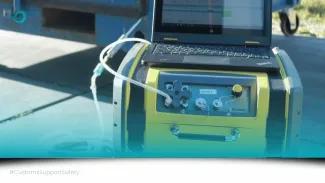These numbers are important because 20% of the containers contain hazardous gases. Depending on the cargo, a wide range of off-gassing production chemicals, sterilants, and fumigants in these containers potentially pose a serious threat to transport workers, warehouse employees, and customs officials. The rise in container shipments also means a rise in risk.
Only a few incidents with gas are reported in the Netherlands, but this doesn’t mean the risk is low. Luckily incidents, where workers get acute poisoning, don’t occur very often. This makes the problem less acute, but not less dangerous. In most cases, the effects of exposure to hazardous gases, especially on a regular basis, are only seen in the long term.
Gas Measurements in Shipping Containers
In the Netherlands, there is legislation that states that employers must investigate if employees can be exposed to the danger of suffocation, intoxication, poisoning and fire or explosion in the working environment. In 2012 the Labour Catalogue Dangerous Gases in Shipping Containers was introduced, which has guidelines and a step by step plan for dealing with dangerous gases. There is a special focus on CMR-substances. CMR stands for Carcinogenic, Mutagenic and Reprotoxic. At low concentrations, these substances can already be very dangerous.
Root Causes for Dangerous Gases in Containers
Containers are often fumigated to combat insects and other pests. Gases most used are phosphine in food products, methyl bromide in wooden products, and ethylene oxide. The last one is used to sterilize medical devices. These gases are intentionally put into the containers.
Another category of gases appears in containers unintentionally. These are dangerous off-gassing gases from products, such as solvents, cleaning agents, and chemicals from glues in packaging materials.
Gas Measurement Techniques and the Advantages of FTIR
The traditional technique to detect and measure gas in containers uses gas detection tubes and sensors. This technique has several disadvantages. It is costly, time-consuming, and can potentially have a standard deviation of up to 20 percent. There are also only a limited number of target gases that can be measured using this technique.
A more sophisticated technique is the Gasmet FTIR technique. One of the biggest advantages of this technique is that FTIR analyzers can detect hundreds of components simultaneously, instead of just one or a limited number. The test results tell you exactly what gases are in a container and in what quantities. The FTIR analyzer works fast and delivers transparent and clear results that are reproducible, and it does so in just a few minutes. The results are real-time. Each gas has its own infrared spectrum which the analyzer can read to determine what gas is in the container.
One of the core values of Customs Support is sustainability, which is the reason we prefer using an FTIR analyzer for gas measurements. This technique uses no consumables, which minimizes waste.
The Advantage and Importance of Risk Analysis
Our extensive and reproducible FTIR-analysis in combination with our reliable database form a solid basis for the risk analysis. In most cases, we quickly find the relation between specific cargoes in containers and their related production chemicals or fumigants. Root cause analyses and categorization of container flows are included in our risk analysis.
Risk analysis can also lead to substantial cost savings by applying random checks in inventoried safe container flows (Category C) in full compliance with the occupational health and safety catalogue ‘Dangerous gases in shipping containers’.
Empowering Global Trade
If you have any questions about gas-related matters, or need support with fumigation or degassing of your shipment, a risk analysis, or any other gas-related issue, please contact one of our trained and experienced specialists. They are happy to help.














